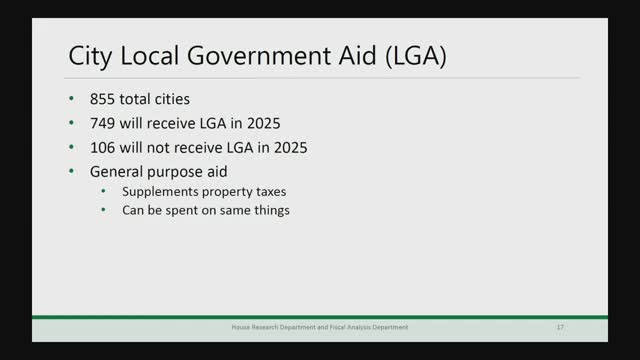House Tax Committee hears details on local-aid programs: LGA, township aid and county program aid
January 22, 2025 | 2025 Legislature MN, Minnesota
This article was created by AI summarizing key points discussed. AI makes mistakes, so for full details and context, please refer to the video of the full meeting. Please report any errors so we can fix them. Report an error »

Jared Swanson, legislative analyst, House Research, briefed the House Tax Committee on state aid programs that supplement property taxes to local governments.
Swanson said the largest general-purpose city aid program is Local Government Aid (LGA), which paid about $644 million annually under a needs‑based formula. For aid payable in 2025, 855 cities were eligible for LGA; 106 of those cities receive $0 under the formula, meaning about 750 cities will actually receive aid in 2025. The formula determines “need” by city size, housing stock age and other factors and subtracts a city’s ability to pay (the statewide average city tax rate applied to the city’s tax base).
Swanson described township aid (town aid), which distributes $10 million annually to all 1,776 townships using a formula that includes the share of the township classified as agricultural property, area and population. He said three counties have no townships (Hennepin, Cook and Lake of the Woods counties were mentioned) and thus receive no township aid payments.
County Program Aid (CPA) distributes about $342 million annually to all 87 counties through two separate formulas: one need‑based (factors include share of population aged 65+, number of Group A offenses, and SNAP households) and one based on county tax base composition. Swanson noted both LGA and CPA are general‑purpose aids with no statutory spending restrictions or routine reporting requirements to the Department of Revenue or the Legislature.
Representative Witty asked whether statutory checks exist to ensure aid is spent on public safety or other priorities; Swanson replied that spending is not specified by statute and that the Legislature would need to enact law to create such restrictions or reporting requirements. Representative Robbins asked about recent increases; Swanson said LGA and CPA each received an $80 million ongoing increase that first took effect in 2024 and that those increases are ongoing and set in statute.
Representative Johnson cautioned against imposing spending mandates on counties, saying counties use CPA to offset state mandates; Representative Harter noted many residents do not see CPA on their property tax notices and therefore may not perceive it as direct tax relief.
Swanson said the largest general-purpose city aid program is Local Government Aid (LGA), which paid about $644 million annually under a needs‑based formula. For aid payable in 2025, 855 cities were eligible for LGA; 106 of those cities receive $0 under the formula, meaning about 750 cities will actually receive aid in 2025. The formula determines “need” by city size, housing stock age and other factors and subtracts a city’s ability to pay (the statewide average city tax rate applied to the city’s tax base).
Swanson described township aid (town aid), which distributes $10 million annually to all 1,776 townships using a formula that includes the share of the township classified as agricultural property, area and population. He said three counties have no townships (Hennepin, Cook and Lake of the Woods counties were mentioned) and thus receive no township aid payments.
County Program Aid (CPA) distributes about $342 million annually to all 87 counties through two separate formulas: one need‑based (factors include share of population aged 65+, number of Group A offenses, and SNAP households) and one based on county tax base composition. Swanson noted both LGA and CPA are general‑purpose aids with no statutory spending restrictions or routine reporting requirements to the Department of Revenue or the Legislature.
Representative Witty asked whether statutory checks exist to ensure aid is spent on public safety or other priorities; Swanson replied that spending is not specified by statute and that the Legislature would need to enact law to create such restrictions or reporting requirements. Representative Robbins asked about recent increases; Swanson said LGA and CPA each received an $80 million ongoing increase that first took effect in 2024 and that those increases are ongoing and set in statute.
Representative Johnson cautioned against imposing spending mandates on counties, saying counties use CPA to offset state mandates; Representative Harter noted many residents do not see CPA on their property tax notices and therefore may not perceive it as direct tax relief.
View full meeting
This article is based on a recent meeting—watch the full video and explore the complete transcript for deeper insights into the discussion.
View full meeting
